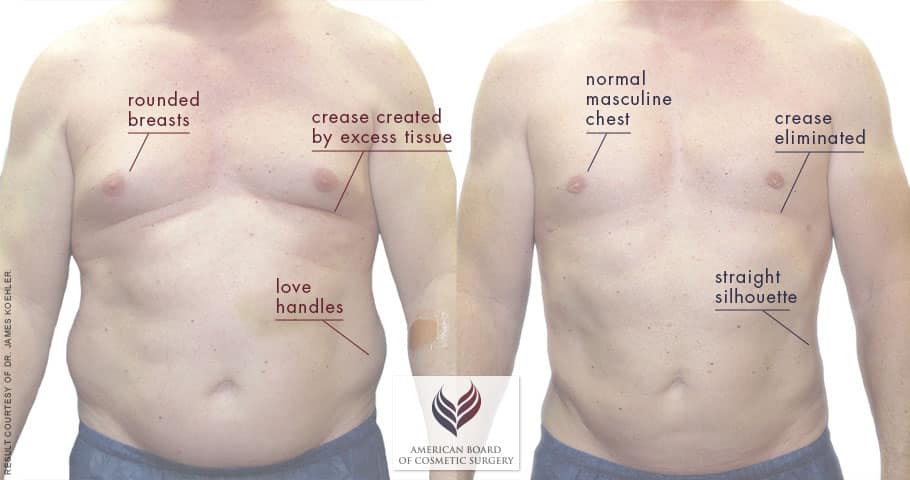Gynecomastia is a condition whereby there is the development of excess breast tissue in males. This is a very common condition and it is estimated that up to 50% of men in the United States experience some degree of gynecomastia during their lifetime.
Even though gynecomastia is not harmful and does not affect the physical health of the patient, the social stigma with men having excess breast skin or enlarged breast tissue can be psychologically damaging and physically uncomfortable. There are various approaches to treat the condition including exercise, medications and surgery.
What Causes Gynecomastia?
Enlargement of breast tissue in men is caused by an imbalance of the hormones testosterone and estrogen. Estrogen is a female hormone that aids the development of breast tissue. When there is excessive production of estrogen or reduction in testosterone, there is resulting breast enlargement. Several things can upset the hormone balance, including the following.
- Natural Hormone Changes
More than half of male infants are born with enlarged breasts due to the effects of their mother’s estrogen. Generally, the swollen breast tissue goes away within two to three weeks after birth. Also during puberty, there is a tendency for males to experience an imbalance in hormone levels. This may result in gynecomastia and it normally resolves within two years.
- Medications
Gynecomastia can also result from taking medications that may impact hormone levels in the body. Examples of such medications include ketoconazole, human growth hormone, antibiotics, cancer medications, anxiety medications, etc.
- Diseases
The development of enlarged breasts has been associated with some disease conditions including Klinefelter’s syndrome, kidney failure, cystic fibrosis, and cancers.

Gynecomastia Surgery | Male Breast Reduction
Treatment of Gynecomastia
There are various approaches to treat the condition including exercise, medications and surgery.
1. Exercise
Mild cases of gynecomastia in adolescence may be treated with advice on lifestyle habits such as proper diet and exercise with reassurance. A good exercise regime has been found to reduce the excess fats in the breast tissue thereby leading to male breast reduction and resolution of gynecomastia.
2. Medications
Certain medications may be effective in male breast reduction. Medical treatment of gynecomastia is most effective when done within the first two years after the start of male breast enlargement. Even though they are not approved by the Food and Drug Administration, some of the medications used for male breast reduction include tamoxifen, raloxifene, clomifene.
3. Gynecomastia Surgery
As stated, medications are most effective when used within the first two years of onset of gynecomastia. If chronic gynecomastia is untreated, surgical removal of glandular breast tissue is usually required. This procedure is referred to as Gynecomastia surgery or male breast reduction surgery.
Gynecomastia surgery is usually performed on an outpatient basis using general anesthesia or local anesthesia plus sedation. The surgery usually takes about an hour and a half to two hours.
There are two techniques with gynecomastia surgery namely the Liposuction technique and Excision technique.
The liposuction technique involves the insertion of a thin hollow tube, known as the cannula, through several small incisions. The cannula is moved back and forth in a controlled motion to loosen the excess fat, which is then removed from the body by vacuum suction.
Excision technique is recommended where glandular breast tissue or excess skin must be removed to correct gynecomastia. Excision also is necessary if the areola will be reduced or the nipple will be repositioned to a more natural male contour. Incision patterns vary depending on the specific conditions and surgical preference.
Related: Lipoma Removal Surgery
Gynecomastia Surgery Risks and Complications
Like every surgical procedure, male breast reduction comes with its risks and complications. Complications of gynecomastia surgery may include:
- Bleeding
- Hematoma
- Surgical wound infection
- Breast asymmetry
- Changes in sensation in the breast
- Necrosis of the areola or nipple
- Seroma
- Noticeable or painful scars
- Contour deformities
Gynecomastia Surgery Cost
The cost of breast reduction surgery varies depending on a lot of factors such as location, surgeon fee and extent of surgery required.
On average, gynecomastia surgery cost ranges between $6,500 and $14,500. This price range includes standard fees such as:
- Surgery facility fee
- Surgeon fee
- Anesthesia fee
- Supplies for the gynecomastia surgery
- Post-surgery follow-up visits
Most health insurance plans do not cover male breast reduction surgery as it’s considered a cosmetic procedure, but many plastic surgeons offer patient financing plans, so be sure to ask.
Gynecomastia Surgery Recovery
For a few days following gynecomastia, you may feel some discomfort that can be controlled with pain medication. You likely will experience bruising and swelling, which can be minimized by wearing a pressure garment for up to two weeks. Most patients find that they are back to their normal activities within a month.


